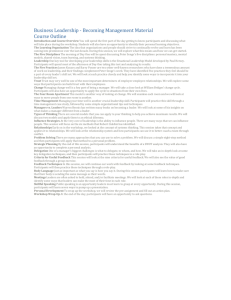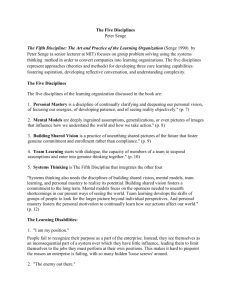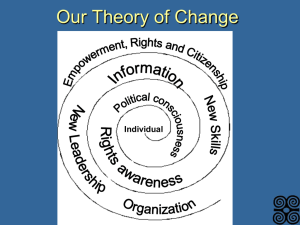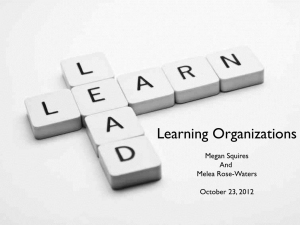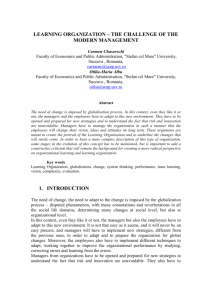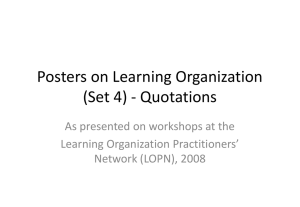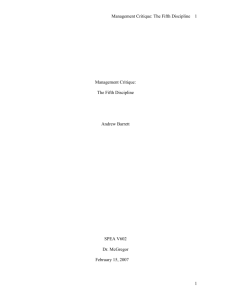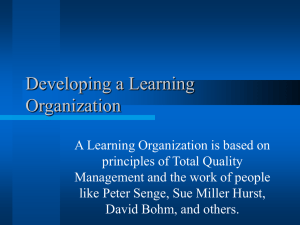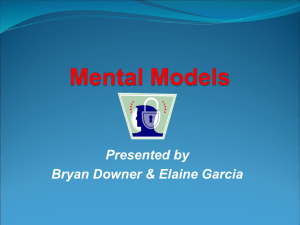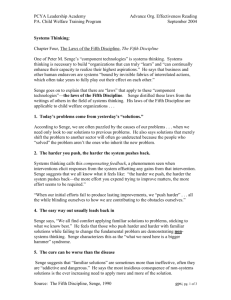The Learning Organization - Public Authority for Applied Education
advertisement
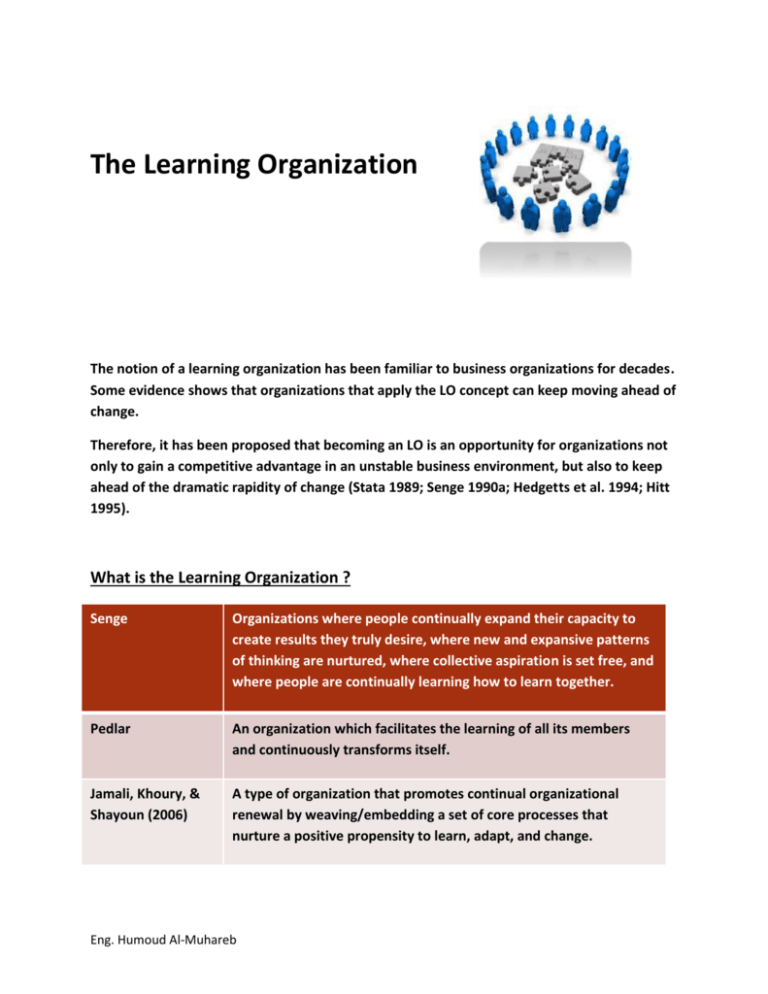
The Learning Organization The notion of a learning organization has been familiar to business organizations for decades. Some evidence shows that organizations that apply the LO concept can keep moving ahead of change. Therefore, it has been proposed that becoming an LO is an opportunity for organizations not only to gain a competitive advantage in an unstable business environment, but also to keep ahead of the dramatic rapidity of change (Stata 1989; Senge 1990a; Hedgetts et al. 1994; Hitt 1995). What is the Learning Organization ? Senge Organizations where people continually expand their capacity to create results they truly desire, where new and expansive patterns of thinking are nurtured, where collective aspiration is set free, and where people are continually learning how to learn together. Pedlar An organization which facilitates the learning of all its members and continuously transforms itself. Jamali, Khoury, & Shayoun (2006) A type of organization that promotes continual organizational renewal by weaving/embedding a set of core processes that nurture a positive propensity to learn, adapt, and change. Eng. Humoud Al-Muhareb What is the Organizational Learning ? Argrys and Schon is under Organizational Theory which focuses and studies on the manners and ways organizations adapt and learns. This is a facet of Organizational Development because Organizational Learning is the interaction that takes place within the individual members of the company. Finger and Brand (1999) is the activity and process by which the organization eventually reaches the ideal Learning Organization. You can view how an organization learns cognitively as a whole, or community based within specific networks within the system. DIMENSIONS OF THE LEARNING ORGANIZATION Individual Level: The learning organization is a place of continuous learning & Learning becomes a conditioned reflex, a habit. Group Level: Teams are encouraged to reflect on how they work, not only so that accomplishments can be celebrated but so that needed improvements can be introduced. Organizational Level: At the level of the organization, learning organizations connect learning to organizational transformation; that is to say, learning is about developing the organization itself. Eng. Humoud Al-Muhareb Types of Learning in organization: The literature on the learning organization often distinguishes two types of learning: Corrective Learning Transformational Learning Single-loop learning Double-loop learning Focuses on identifying and correcting errors of one kind or another, with the intent naturally of correcting these errors and introducing improvements A form of learning that questions the norms, procedures, practices, processes, systems, and structures that corrective learning takes for granted. This form of learning does not aim at questioning organizational processes, structures, procedures, or practices. Rather, it takes them for granted; it works within them. Organizations find transformational learning difficult and uncomfortable precisely because it involves questioning deeply held opinions and beliefs. Traditionally, productive organizations have been viewed as centers of work. However, The Learning Organization sees the productive organization as not only a center of work, but also a center of learning. Eng. Humoud Al-Muhareb Why is the learning organization important? Stability is yielding to change Change is constant Rate of change is increasing geometrically: * Technology * Science * Standard of living Process of Learning Organization: 1. Obtaining knowledge from external and internal environment of organization. 2. Distribution of information, means that organization can share the obtained information with its departments and members. 3. Information interpretation, in order to make the distributed information find collective understandable meanings. 4. Organizational memory, it means that it’s a store in which knowledge is storing for use in the future. Learning Organization Leader Peter Senge An American scientist born in 1947. Strategist of the Century Director of center for Organizational Learning at MIT school of Management. Author of “The Fifth Discipline” in 1990. In his book he explain about the concept of learning organization. Eng. Humoud Al-Muhareb According to Peter Senge: Why should organizations become Learning organization ? For companies to be able to adapt to changing environments and stay ahead of their competition To improve the workforce skill-set To improve communication among employees To improve productivity and make the employees feel like they are an important entity of the company. To overcome companies weaknesses and to utilize their strength more efficiently Peter Senge’s Five Disciplines: Senge (1990) visualizes the learning organization to continually expand it capacity to create its future. His five disciplines constituting a learning organization, namely, personal mastery, mental models, shared vision, team learning and systems thinking, have received much attention. Systems Thinking Personal Mastery Team Learning Mental Models Shared Vision Peter Senge’s Five Disciplines Eng. Humoud Al-Muhareb (1) Personal Mastery Organizations can’t learn unless their members begin to Learn and develop their personal abilities to achieve desired results. Personal abilities and competences means to be active able to, to have a creative attitude toward life, to live actively and not to be passive. It is the discipline of continually clarifying and deepening our personal vision, of focusing our energies, of developing patience, and seeing reality objectively. (Senge 1990: 139) (2) Mental Model Mental models determine how a person thinks and acts. Even though people always don't act according to their mental models, their behaviors are based on a mental image (Senge 1990). In the learning organization, mental models are the discipline of consideration, discussion, dialogue and study. With this discipline people try to reach some agreement about suitable and realistic mental models. The deeply ingrained assumptions, generalizations, and even pictures or images that influence how we understand the world. (3) Shared Vision Consists of the capacity to create a shared image and view of a future which we pursue it. A collective experience which is the total of each participant’s personal vision. Senge (1990) believes that action and reaction with people shape a shared vision which created only via the awareness of organization goals and compatibility between individual visions and developing these visions, towards general purpose. Eng. Humoud Al-Muhareb (4) Team Learning As Senge says, the world is full talented people, but it is important that they should know how to work and act together. Senge (1990) suggests two important components in team learning, the first, conversation and the second Practice. Team learning, is seen to be crucial because team, not individuals, are the fundamental teaching unit in modern organization. (Senge 1990). (5) System Thinking Systems thinking is a way holistic. It is a framework that emphasize on understanding of internal relations of phenomena, not on identifying them one by one. Senge sees systems thinking at the heart of his "learning organization" models, where all of organization members develop an understanding of the whole rather than just fractional parts of organization in terms of structures, processes, thinking and behavior. Benefits of Adopting the 5 Disciplines Less use of defensive routines in work and more proactivity Greater trust Faster change More effective communication flows Group self-awareness Collective learning & creativity Eng. Humoud Al-Muhareb In conclusion, The learning organization is a self‐reflective organization. It not only seeks to achieve results, but also seeks to understand how it achieves results. It actively seeks to learn from its successes and failures. It asks itself difficult questions, can discuss its weaknesses openly, and has the courage to correct itself. It regularly challenges its basic assumptions about how things are done. In sum, it seeks to overcome routine excuses. Eng. Humoud Al-Muhareb References 1. A Primer on the Learning Organization. (2007). 2. Canada School of Public Service, Progress Report 2002-2003. Retrieved from : www.myschool-monecole.gc.ca/ldc/2003/progress_rpt/prog_rep_02_e.html 3. Najafbagy, R., & Doroudi, H. (2010). MODEL OF LEARNING ORGANIZATION IN BROADCASTING ORGANIZATION OF ISLAMIC REPUBLIC OF IRAN. Serbian Journal of Management, 5(2), 213225. 4. Senge, P. (1990). The fifth discipline: The art and practice of the learning organization. New York: Doubleday/Currency. 5. Senge, P. (1990). The leader's new work: Building learning organizations. Cambridge, Mass.: Sloan Management Review. 6. Sudharatna, Y., & Li, L. (2004). Learning Organization Characteristics Contributed to its Readiness-to-Change: A Study of the Thai Mobile Phone Service Industry. Managing Global Transitions, 2(2), 163-178. 7. Suveatwatanakul, C. (2013). EFFECT OF KNOWLEDGE SHARING FACTORS ON THE LEARNING ORGANISATION IN TOURISM AND HOSPITALITY. ISS & MLB. Eng. Humoud Al-Muhareb
